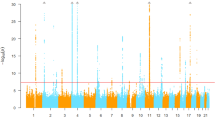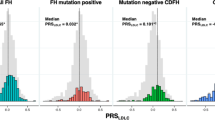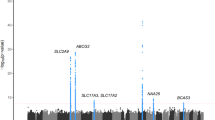Abstract
Background
Genetic risk score (GRS) is a useful way to explore genetic architectures and the relationships of complex diseases. Several studies had revealed many single nucleotide polymorphisms (SNPs) associated with the efficacy of folic acid treatment to hyperhomocysteinemia (HHcy).
Methods
We aimed to construct and screen out the optimal predictive model based on four GRSs and traditional risk factors. Four GRSs enrolled four SNPs (MTHFR rs1801131, MTHFR rs1801133, MTRR rs1801394, BHMT rs3733890) were presented as follows: (a) simple count genetic risk score (SC-GRS), (b) direct logistic regression genetic risk score (DL-GRS), (c) polygenic genetic risk score (PG-GRS), and (d) explained variance weighted genetic risk score (EV-GRS). We performed a prospective cohort study including 638 HHcy patients. Then we evaluated the associations of four GRSs with folic acid’s efficacy and the performance of four GRSs.
Results
Four GRSs were independently associated with efficacy of treatment (p < 0.05). When combining GRSs with traditional risk factors, the AUC of the four models were all above 0.900 in the training set (Tradition + SC-GRS: 0.909, Tradition + DL-GRS: 0.909, Tradition + PG-GRS: 0.904, Tradition + EV-GRS: 0.910). And EV-GRS got the highest AUC. When evaluating the models in the testing set, we got the same conclusion that EV-GRS was optimal among four GRSs with the highest AUC (0.878) and the highest increase of AUC (0.008).
Conclusion
A more precise predictive model combing the optimal GRS with traditional risk factors was constructed to predict the efficacy of folic acid therapy to HHcy.
This is a preview of subscription content, access via your institution
Access options
Subscribe to this journal
Receive 12 print issues and online access
$259.00 per year
only $21.58 per issue
Buy this article
- Purchase on Springer Link
- Instant access to full article PDF
Prices may be subject to local taxes which are calculated during checkout
Similar content being viewed by others
References
Ohishi T, Fujita T, Suzuki D, Nishida T, Asukai M, Matsuyama Y. Serum homocysteine levels are affected by renal function during a 3-year period of minodronate therapy in female osteoporotic patients. J Bone Miner Metab. 2019;37:319–26.
Messedi M, Frigui M, Chaabouni K, Turki M, Neifer M, Lahiyani A, et al. Methylenetetrahydrofolate reductase C677T and A1298C polymorphisms and variations of homocysteine concentrations in patients with Behcet’s disease. Gene. 2013;527:306–10.
Peng HY, Man CF, Xu J, Fan Y. Elevated homocysteine levels and risk of cardiovascular and all-cause mortality: a meta-analysis of prospective studies. J Zhejiang Univ Sci B. 2015;16:78–86.
Schaffer A, Verdoia M, Cassetti E, Marino P, Suryapranata H, De Luca G, et al. Relationship between homocysteine and coronary artery disease. results from a large prospective cohort study. Thromb Res. 2014;134:288–93.
Cheng X. Updating the relationship between hyperhomocysteinemia lowering therapy and cardiovascular events. Cardiovasc Ther. 2013;31:e19–26.
Clarke R, Smith AD, Jobst KA, Refsum H, Sutton L, Ueland PM. Folate, vitamin B12, and serum total homocysteine levels in confirmed Alzheimer disease. Arch Neurol. 1998;55:1449–55.
Dhonukshe-Rutten RA, de Vries JH, de Bree A, van der Put N, van Staveren WA, de Groot LC. Dietary intake and status of folate and vitamin B12 and their association with homocysteine and cardiovascular disease in European populations. Eur J Clin Nutr. 2009;63:18–30.
Mahmud N, Molloy A, McPartlin J, Corbally R, Whitehead AS, Scott JM, Weir DG, et al. Increased prevalence of methylenetetrahydrofolate reductase C677T variant in patients with inflammatory bowel disease, and its clinical implications. Gut. 2000;47:456–457.
Yajnik CS, Chandak GR, Joglekar C, Katre P, Bhat DS, Singh SN, et al. Maternal homocysteine in pregnancy and offspring birthweight: epidemiological associations and Mendelian randomization analysis. Int J Epidemiol. 2014;43:1487–97.
Wang B, Wu H, Li Y, Ban Q, Huang X, Chen L, et al. Effect of long-term low-dose folic acid supplementation on degree of total homocysteine-lowering: major effect modifiers. Br J Nutr. 2018;120:1122–30.
Tian H, Tian D, Zhang C, Wang W, Wang L, Ge M, et al. Efficacy of folic acid therapy in patients with hyperhomocysteinemia. J Am Coll Nutr. 2017;36:528–32.
Mao X, Xing X, Xu R, Gong Q, He Y, Li S, et al. Folic acid and vitamins D and B12 correlate with homocysteine in Chinese patients with type-2 diabetes mellitus, hypertension, or cardiovascular disease. Medicine. 2016;95:e2652.
Zappacosta B, Mastroiacovo P, Persichilli S, Pounis G, Ruggeri S, Minucci A, et al. Homocysteine lowering by folate-rich diet or pharmacological supplementations in subjects with moderate hyperhomocysteinemia. Nutrients. 2013;5:1531–43.
Tian H, Tian D, Zhang C, Wang W, Wang L, Ge M, et al. Efficacy of folic acid therapy in patients with hyperhomocysteinemia. J Am Coll Nutr. 2017;36:528–32.
Huang X, Li D, Zhao Q, Zhang C, Ren B, Yue L, et al. Association between BHMT and CBS gene promoter methylation with the efficacy of folic acid therapy in patients with hyperhomocysteinemia. J Hum Genet. 2019;64:1227–35.
Huang X, Zhao Q, Li D, Ren B, Yue L, Shi F, et al. Association between gene promoter methylation of the one-carbon metabolism pathway and serum folate among patients with hyperhomocysteinemia. Eur J Clin Nutr. 2020;74:1677–84.
Du B, Tian H, Tian D, Zhang C, Wang W, Wang L, et al. Genetic polymorphisms of key enzymes in folate metabolism affect the efficacy of folate therapy in patients with hyperhomocysteinaemia. Br J Nutr. 2018;119:887–95.
Du B, Zhang C, Yue L, Ren B, Zhao Q, Li D, et al. Prediction model for the efficacy of folic acid therapy on hyperhomocysteinaemia based on genetic risk score methods. Br J Nutr. 2019;122:39–46.
Zhao Y, Ning Y, Zhang F, Ding M, Wen Y, Shi L, et al. PCA-based GRS analysis enhances the effectiveness for genetic correlation detection. Brief Bioinform. 2019;20:2291–8.
Natarajan P, Young R, Stitziel NO, Padmanabhan S, Baber U, Mehran R, et al. Polygenic risk score identifies subgroup with higher burden of atherosclerosis and greater relative benefit from statin therapy in the primary prevention setting. Circulation. 2017;135:2091–101.
Marston NA, Kamanu FK, Nordio F, Gurmu Y, Roselli C, Sever PS, et al. Predicting benefit from evolocumab therapy in patients with atherosclerotic disease using a genetic risk score: results from the FOURIER trial. Circulation. 2020;141:616–23.
Talmud PJ, Hingorani AD, Cooper JA, Marmot MG, Brunner EJ, Kumari M, et al. Utility of genetic and non-genetic risk factors in prediction of type 2 diabetes: whitehall II prospective cohort study. BMJ. 2010;340:b4838.
Carayol J, Tores F, Konig IR, Hager J, Ziegler A. Evaluating diagnostic accuracy of genetic profiles in affected offspring families. Stat Med. 2010;29:2359–68.
Che R, Motsinger-Reif AA. A new explained-variance based genetic risk score for predictive modeling of disease risk. Stat Appl Genet Mol Biol. 2012;11:Article 15.
Liu CS, Chiang HC, Chen HW. Methylenetetrahydrofolate reductase polymorphism determines the plasma homocysteine-lowering effect of large-dose folic acid supplementation in patients with cardiovascular disease. Nutrition. 2004;20:974–8.
Huang X, Qin X, Yang W, Liu L, Jiang C, Zhang X, et al. MTHFR gene and serum folate interaction on serum homocysteine lowering: prospect for precision folic acid treatment. Arterioscler Thromb Vasc Biol. 2018;38:679–85.
Kruger WD, Evans AA, Wang L, Malinow MR, Duell PB, Anderson PH, et al. Polymorphisms in the CBS gene associated with decreased risk of coronary artery disease and increased responsiveness to total homocysteine lowering by folic acid. Mol Genet Metab. 2000;70:53–60.
Malinow M, Nieto F, Kruger W, Duell P, Hess D, Gluckman R, et al. The effects of folic acid supplementation on plasma total homocysteine are modulated by multivitamin use and methylenetetrahydrofolate reductase genotypes. Arterioscler Thromb Vasc Biol. 1997;17:1157–62.
Janipalli C, Kumar M, Vinay D, Sandeep M, Bhaskar S, Kulkarni S, et al. Analysis of 32 common susceptibility genetic variants and their combined effect in predicting risk of Type 2 diabetes and related traits in Indians. Diabet Med. 2012;29:121–7.
Ripatti S, Tikkanen E, Orho-Melander M, Havulinna AS, Silander K, Sharma A, et al. A multilocus genetic risk score for coronary heart disease: case-control and prospective cohort analyses. Lancet. 2010;376:1393–400.
Wu J, Pfeiffer RM, Gail MH. Strategies for developing prediction models from genome-wide association studies. Genet Epidemiol. 2013;37:768–77.
Dudbridge F. Power and predictive accuracy of polygenic risk scores. PLoS Genet. 2013;9:e1003348.
Wang Y, Yan Q, Xu J, Li X, Cheng M. High prevalence and factors contributing to hyperhomocysteinemia, folate deficiency, and vitamin b12 deficiency among healthy adults in Shanghai, China. Biomed Environ Sci. 2019;32:63–7.
Balavarca Y, Weigl K, Thomsen H, Brenner H. Performance of individual and joint risk stratification by an environmental risk score and a genetic risk score in a colorectal cancer screening setting. Int J Cancer. 2020;146:627–34.
Hernandez RD, Uricchio LH, Hartman K, Ye C, Dahl A, Zaitlen N. Ultrarare variants drive substantial cis heritability of human gene expression. Nat Genet. 2019;51:1349–55.
Sidore C, Busonero F, Maschio A, Porcu E, Naitza S, Zoledziewska M, et al. Genome sequencing elucidates Sardinian genetic architecture and augments association analyses for lipid and blood inflammatory markers. Nat Genet. 2015;47:1272–81.
Fava C, Sjogren M, Olsson S, Lovkvist H, Jood K, Engstrom G, et al. A genetic risk score for hypertension associates with the risk of ischemic stroke in a Swedish case-control study. Eur J Hum Genet. 2015;23:969–74.
Zupancic K, Skok K, Repnik K, Weersma RK, Potocnik U, Skok P. Multi-locus genetic risk score predicts risk for Crohn’s disease in Slovenian population. World J Gastroenterol. 2016;22:3777–84.
Redondo MJ, Oram RA, Steck AK. Genetic risk scores for type 1 diabetes prediction and diagnosis. Curr Diabetes Rep. 2017;17:129.
Vezzoli A, Dellanoce C, Maria Caimi T, Vietti D, Montorsi M, Mrakic-Sposta S, et al. Influence of dietary supplementation for hyperhomocysteinemia treatments. Nutrients. 2020;12:1957.
Acknowledgements
We thank all the staff of the Department of Neurology, the Fifth Affiliated Hospital of Zhengzhou University, for their support and assistance. All authors had read and approved the final manuscript. This work was supported by the Department of Science and Technology of Henan Province (No.132102310431).
Author information
Authors and Affiliations
Contributions
The responsibilities of all authors were as follows: XC had full access to all the study and was responsible for the integrity and the analysis of the data. CZ and XH acquired the data of this study. XW carried out the data analysis. WZ was in charge of supervision and reviewing. All authors have read and approved the final version of the manuscript.
Corresponding author
Ethics declarations
Competing interests
The authors declare no competing interests.
Additional information
Publisher’s note Springer Nature remains neutral with regard to jurisdictional claims in published maps and institutional affiliations.
Supplementary information
41430_2021_1055_MOESM1_ESM.docx
Supplementary Table 1 Association between different GRSs (category variable) and the efficacy of folic acid therapy for HHcy
Rights and permissions
About this article
Cite this article
Chen, X., Huang, X., Zheng, C. et al. Using the optimal method—explained variance weighted genetic risk score to predict the efficacy of folic acid therapy to hyperhomocysteinemia. Eur J Clin Nutr 76, 943–949 (2022). https://doi.org/10.1038/s41430-021-01055-5
Received:
Revised:
Accepted:
Published:
Issue Date:
DOI: https://doi.org/10.1038/s41430-021-01055-5



